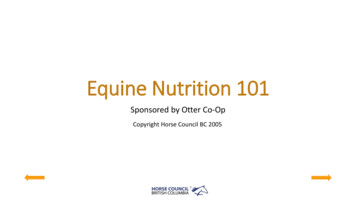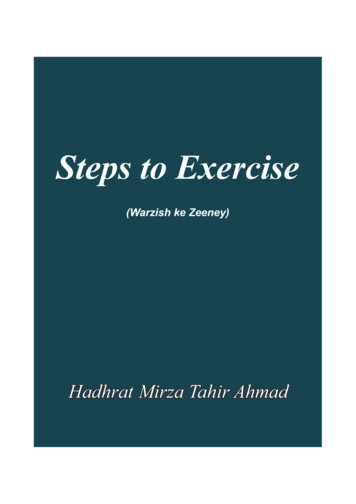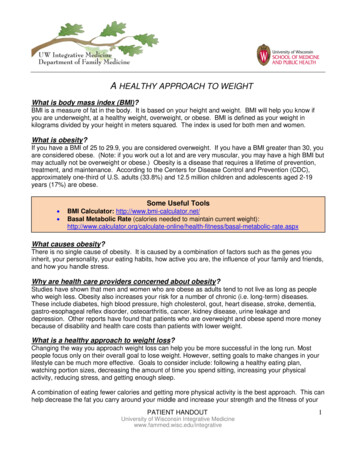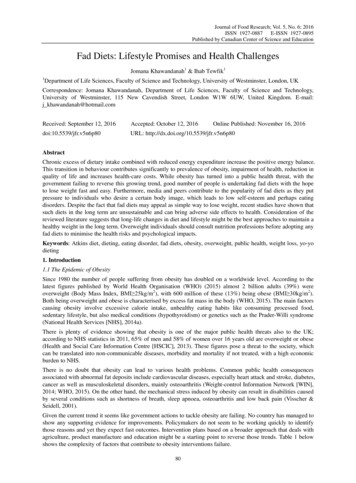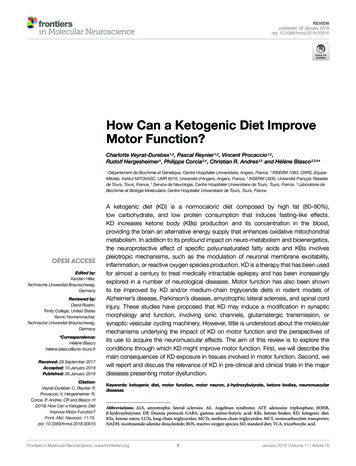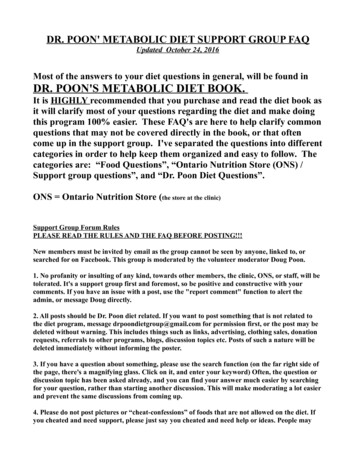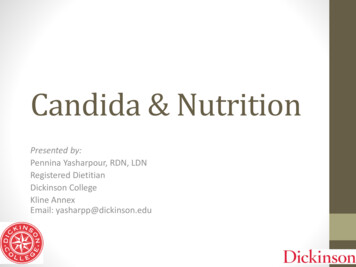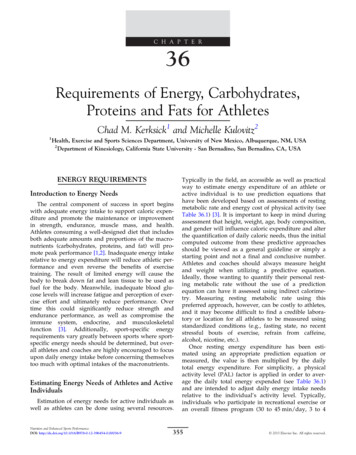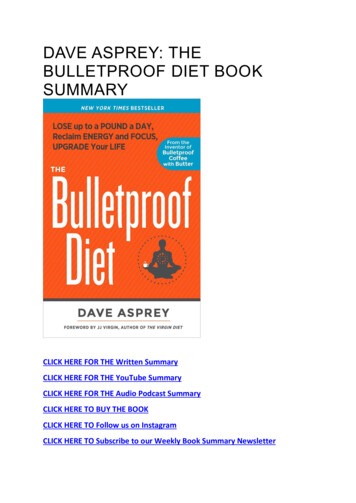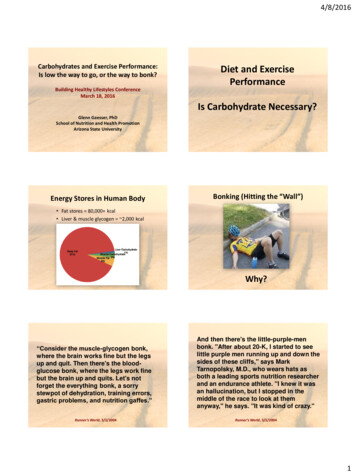
Transcription
4/8/2016Carbohydrates and Exercise Performance:Is low the way to go, or the way to bonk?Building Healthy Lifestyles ConferenceMarch 18, 2016Diet and ExercisePerformanceIs Carbohydrate Necessary?Glenn Gaesser, PhDSchool of Nutrition and Health PromotionArizona State UniversityEnergy Stores in Human BodyBonking (Hitting the “Wall”) Fat stores 80,000 kcal Liver & muscle glycogen 2,000 kcalWhy?“Consider the muscle-glycogen bonk,where the brain works fine but the legsup and quit. Then there's the bloodglucose bonk, where the legs work finebut the brain up and quits. Let's notforget the everything bonk, a sorrystewpot of dehydration, training errors,gastric problems, and nutrition gaffes.”Runner’s World, 3/1/2004And then there's the little-purple-menbonk. "After about 20-K, I started to seelittle purple men running up and down thesides of these cliffs," says MarkTarnopolsky, M.D., who wears hats asboth a leading sports nutrition researcherand an endurance athlete. "I knew it wasan hallucination, but I stopped in themiddle of the race to look at themanyway," he says. "It was kind of crazy."Runner’s World, 3/1/20041
4/8/2016Maximum Rates of Energy Production fromCarbohydrates and FatsEnergy Production 101CarbohydratesFastSlowFatsATP synthesisvia oxidativephoshorylationATP synthesisvia oxidativephoshorylationATP synthesisvia oxidativephoshorylationATP synthesisvia oxidativephoshorylationCrossover Concept in Fuel UtilizationGaesser, Agro Food Industry Hi-Tech,Muscle Glycogen Use IncreasesDramatically as Exercise Intensity IncreasesBecause fat burns more slowlythan carbohydrates, muscleglycogen (the major storedform of carbohydrate in thebody) use is essential tosustain high-intensity exercise.Especially important for: Sudden increases in pace The sprint at the end of theraceMost competitive endurance athletes are at 70% VO2maxduring high-intensity training and during competitive racesCHO is the dominant fuelBrooks and Mercier, J Appl Physiol, 1994;76:2253-2261.Exercise Intensity and Glycogen UtilizationOnly at very low to moderate exercise intensities is the rate ofmuscle glycogen use so low that consuming a low carbohydratediet would not matter.Garrow and Grisham, Biochemistry, 3rd edition, 2004, p. 772Hultman and Spriet, In: Exercise, Nutrition and Energy Metabolism,Horton and Terjung (eds), Macmillan: New York, 1988, 132-149Muscle Glycogen Use is High Even inIntermittent EffortsSoccer, football, lacrosse and other “team” sports are not steady stateathletic efforts. Still, athletes use a great deal of stored glycogen.Agnevik, Sport Physiol Report Number 7 (Swedish) Trygg-Hansa, Stockholm, 19702
4/8/2016Muscle Glycogen and Time to ExhaustionAthletes on highcarbohydrate diets storemore muscle glycogen.Muscle Glycogen ReplenishmentDuring Consecutive Days of Hard ExerciseHigh-Carb vs. Low-Carb DietHigh-Carb DietThe greater the amount ofmuscle glycogen the longerthe time to exhaustionwhen exercising.Bergstrom et al. Acta Physiol Scand, 1967;71:140-150Classic CHO Loading“Supercompensation” Regimen ( 1970)Low-Carb DietCostill, Inside Running, Benchmark Press, Indianapolis, 1986, p. 63Endurance Intensities are Well Abovethe “Fat Burning” Zone It was initially thought that a “depletionphase” was necessary to maximizeglycogen “supercompensation” Subsequent research indicated this is notnecessary Excessive carbohydrate intake during thefinal 3 days before competition is notnecessary Just a simple taper with moderate-tohigh intake of CHO increase muscleglycogen levels by 60%.Ahlborg, Forvarsmedicin, 1967;3:85-99Achten and Jeukendrup, Nutrition, 2004;20:716-727Endurance Sports Require Efforts Above theLactate Threshold ( 2-5 mmol/l)Fat oxidationfalls offsharply asblood lactateconcentrationincreases.Summary: Carbohydrate & ExerciseCarbohydrate: Preferred during moderate tohigh intensity exercise Increases time to exhaustionduring higher intensity exercise Replaces glycogen stores muchfaster after exercise fasterrecovery “FAST” fuel (releases caloriesfaster); fat is a “SLOW” to burnfuelAchten and Jeukendrup, Int J Sports Med, 2004;25:32-373
4/8/2016Low Carbohydrate Intake and Exercise:Train “Low” – Race “High”The Origins of Train “Low” – Race “High”Why all the hype? Anecdotal testimonials Popularity of the Paleo Diet Recent scientific evidence “Classic” study by Phinney et al(1983)What’s the rationale?Does it work?Low Carbohydrate Did Not Improve Endurance TimeCloser Examination of the Study byPhinney et alEndurance Time At 62-64% Vo2maxBefore And After 4 Weeks Of A Ketogenic DietMetabolism, 1983, 32: 769-776Five well-trained male cyclists consumed a ketogenic diet for fourweeksAuthors’ conclusion:“These results indicate that aerobic endurance exercise by well-trained cyclistswas not compromised by four weeks of ketosis”Endurance Time, minutes250200150100500Before Ketogenic DietAfter Ketogneic DietPhinney et al, Metabolism, 1983, 32: 769-776Endurance time at 62-64% VO2maxbefore and after 4 weeks of a ketogenic dietEndurance Time, minutes250Individual Data**Ironically, these two subjects increased fat oxidation themost on the ketogenic diet200Subject 1150 Yes, two subjects performed better But two subjects performed worse** And one subject performed the sameAnd this is the most cited study as an endorsementof a ketogenic diet for endurance performance!?Subject 2Subject 3100Subject 4Subject 5500Before Ketogenic DietAfter Ketogneic DietPhinney et al, Metabolism, 1983, 32: 769-776Phinney et al, Metabolism, 1983, 32: 769-7764
4/8/2016Altering Fatty Acid Availability does not impairprolonged, continuous running to fatigueEvidence for Carbohydrate DependenceFurthermore, very few endurance contests areperformed at an intensity of only 63% of VO2maxThere is no published evidence that a lowcarbohydrate diet will improve enduranceperformance at high (race competitive) exerciseintensitiesTrained runners, four trials95% of PB half-marathon time CFED: Carbohydrate ingestion before and duringCFED – NA: CFED nicotinic acid (inhibits lipolysis)FAST: Fasted with placebo ingestionFAST – NA: FAST NALeckey et al, J Appl Physiol 2015, in pressProtocol OverviewFree-fatty acidand glycerolconcentrationsduring exerciseLeckey et al, J Appl Physiol 2015, in pressLeckey et al, J Appl Physiol 2015, in pressCarbohydrate and Fat Burned During RunDistance Covered During RunLeckey et al, J Appl Physiol 2015, in pressLeckey et al, J Appl Physiol 2015, in press5
4/8/2016ConclusionsDoes the High-Carb Approach Work? Blunting availability of free-fatty acids didnot impair intense running capacitylasting 85 minutes While there was a small, but obligatoryuse of fat, the oxidation of carbohydratebased fuels predominates during halfmarathon running.95 of the top 100marathon performancesever recorded are byKenyans and EthiopiansMacronutrient Intake of theWorld’s Best 412.4Can a modified strategy, using both“low-carb” and “normal/high-carb”dietary practices, enhanceperformance?Onywera et al, Int J Sport Nutr Exerc Metab, 2004;14:709-719Beis et al, J Int Soc Sports Nutr, 2011;8:1-7 (Open Access)Train “Low” – Race “High”The ScienceScientific evidence is limited to a handful ofshort-term studies with this design:Two groups of athletes, randomized to twotraining conditions, both receiving the samedaily carbohydrate intake: “Train high”: 1 training session per day “Train low”: 2 trainings sessions perday, alternating days, with nocarbohydrate repletion betweensessions on the same day (i.e., thesecond training session is performedunder “low-carb” conditions)Train “Low” – Race “High”The Results Better skeletal muscleadaptations under the“train low” condition Higher exercise toleranceand greater workperformed under “trainhigh” condition NO DIFFERENCE INPERFORMANCE MEASURES6
4/8/2016Endurance Training on Low-Carbohydrateand Grain-Based Diets: A Case StudyGrain-Based Diet for Endurance AthleteStudy Details: 34-year-old male triathlete Consistent training sinceage 15 Two 14-day diets (5-weekwash-out) Atkins “inductionphase” Grain-based All food providedPurpose:To illustrate the effects of low-carbohydrate andgrain-based diets on body composition, biomarkers,athletic training, and performance in an elite triathleteRosenkranz et al, Int J Sport Nutr Exerc Metab, 2007;17:296-309Endurance Athlete Case Study:Low Carb vs. Grain-Based DietMacronutrient Composition of Each DietLow-Carb DietGrain-based DietKey Results Athlete lost weight on the low-carb diet (3.2 kg) During a 5K cycle ergometer performance ride:Habitual Diet Power output maintained was the same for both diets Heart rate and “perceived exertion” were higher on low-carb dietCHOFATPROTEIN Training impact of low-carb diet was significant: 6 workouts cut short on low-carb vs. 2 on grain-based diet Unplanned decrease in training intensity during 5 workouts on low-carbdiet, none on grain-based diet During the low-carb diet: Lethargy and fatigue mentioned every day in the training log (after thethird day)Macronutrient composition of“Grain-based Diet”more closely matched “Habitual Diet”Low Carb vs. Grain-Based Diets:ConclusionDespite very little weight loss on the low-carbohydratediet, exercise training was more difficult. The primaryobservation was a disruption to scheduled training onthe low-carbohydrate diet that was not observed on thegrain-based diet. Frequent cravings for sweetsInterrupted sleepPersistent muscle sorenessPsychological difficultiesHigh Carb DayLow Carb DayNo Carb Day7
4/8/2016Practical Applications forTrain “Low” – Race “High”Potential Pitfalls of “Training Low” Chronic low-carb diet may compromise ability to maintaindesired training intensity High amounts of exercise performed in a low-carb state mayincrease susceptibility to illness and infection (Carbs play animportant role in offsetting exercise-inducedimmunosuppression) Exercising under conditions of low-carbohydrate availability mayincrease protein breakdown (could impair maintenance ofmuscle mass) Exercising while limiting carbohydrate intake may impaircapacity to utilize carbohydrate consumed during competition Train in a fasted state Morning exercise before eating Two training sessions per day (no CHO replenishment afterfirst session) Train “low” workouts should not be intense Athletes should consider caffeine ingestion and/or CHO mouthrinse on train “low” days Protein ingestion (20-25 grams) should be ingested before,during and/or right after a train “low” exercise session Training program should include sessions of training “high”that simulate competition fueling scheduleBartlett et al, Eur J Sport Sci, 2015;1:3-12So Why Does The Train Low/Race HighConcept Persist?Bartlett et al, Eur J Sport Sci, 2015;1:3-12Potential Pitfalls of Too Much Protein in theDiet (which may occur on a Paleo diet)A number of studies published in the past 35 years haveshown that high protein intake impairs the capacity forvery high-intensity exerciseDietary Acid-Base IntakeThe Effects of Dietary Manipulation onBlood Acid-Base Status and the Performanceof High-Intensity Exercise Control (46.2 % CHO; 39.2 % Fat; 14.1 % Protein) Low-Carb (10.1 % CHO; 64.5 % Fat; 25.3 % Protein) High-Carb (65.5 % CHO; 24.7 % Fat; 9.4 % Protein)Greenhaff et al, Eur J Appl Physiol, b0BASEEleven healthy men performed exercise to exhaustionunder three dietary conditions:100-20-40Greenhaff et al, Eur J Appl Physiol, 1987;56:331-3378
4/8/2016Exercise Time at a Fixed Workload( 100% VO2max)40056% greater endurance350345Exercise Time, SecondsResults of this study have beenreplicated a number of e-home message:Exercise performance at very high intensities isreduced by a low-carb diet that is relatively high inprotein ( 2 grams/kg/day)The adverse effects of high protein intakes is likely dueto increasing acid load and reducing buffering capacityof the blood100500Greenhaff et al, Eur J Appl Physiol, 1987;56:331-337Daily Needs for Fuel and RecoveryGuidelines For Fueling Before, Duringand After ExerciseIntensitySituationLightLow-intensity or skill-basedactivitiesModerate exercise program( 1 h/day)Endurance program(1-3 h/day of moderate-tovigorous activity)Extreme commitment( 4-5 h/day of moderate-tovigorous activity)ModerateHighVery HighDaily CHO targets(grams per kgbody weight)3-55-76-108-12Burke et al, J Sports Science, 2011, 29 (S1): S17-S27.Acute fueling StrategiesIntensityGeneralfueling upSituationCHO targetsPreparation for events 90 min 7-12 g/kg per 24 hCarbohydrate Preparation for events 90 min 10-12 g/kg per 24 hloading(sustained or intermittent)for 36-48 hSpeedyrefueling 8 h recovery between twodemanding sessions1.0-1.2 g/kg/h forfirst 4 h, thenresume daily fuelneedsBurke et al, J Sports Science, 2011, 29 (S1): S17-S27.Acute fueling Strategies (continued)IntensityPre-event fuelingSituationBefore exercise 60 minDuring briefexerciseDuring sustainedhigh-intensityexercise 45 min45 – 75 minCHO targets1-4 g/kg consumed1-4 h beforeexerciseNot necessarySmall amountsincluding mouthrinseBurke et al, J Sports Science, 2011, 29 (S1): S17-S27.9
4/8/2016Acute fueling Strategies ing “stopand start” sports)During ultraenduranceexerciseSituation1.0 – 1.5 hCHO targets30-60 g/hour 2.5 – 3.0 hUp to 90 g/hourBurke et al, J Sports Science, 2011, 29 (S1): S17-S27.Summary Points and CommentsEndurance Performance Carbohydrate is a “faster” fuel than fat Faster rate of breakdown to CO2 and H2O More energy (ATP) can be produced in a givenamount of time (i.e., per minute) Carbohydrates are essential for high-intensityexercise Carbohydrates provide more energy (ATP) per literof oxygen consumed Maximum rate of energy production is 3-5 timeshigher from CHO compared to fatBody Weight Does Not Affect OxidationRate of CHO Intake During ExerciseBurke et al, J Sports Science, 2011, 29 (S1): S17-S27.Summary Points and CommentsEndurance Performance Initial muscle glycogen levels are important forendurance sports lasting 90 minutes There is no evidence to show that a low-carbohydratediet will improve competitive endurance sportperformance by more than a moderate-to-high CHOdiet Low-carb diets may impair an athlete’s capacity forperforming and completing high-intensity workouts High-protein content of some low-carb diets mayreduce tolerance for high-intensity and maximalexerciseSummary Points and CommentsEndurance Performance Train “low” – race “high” method Skeletal muscle adaptations are enhanced But actual endurance performance has not beenshown to be improved Even with train “low” – race “high” there is a need foradequate CHO The world’s best marathoners consume highcarbohydrate diets ( 60%).10
before and after 4 weeks of a ketogenic diet Individual Data 0 50 100 150 200 250 Before Ketogenic Diet After Ketogneic Diet s Subject 1Subject 2 Subject 3 Subject 4 Subject 5 Phinneyet al, Metabolism, 1983, 32: 769-776 **Ironically, these two subjects increased fat oxidation the most on the ketogenic

